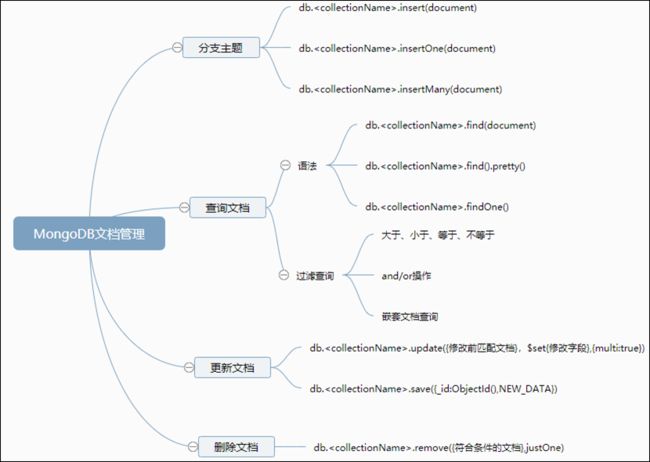(一)插入文档
插入文档一共有3种方法,分别如下:
# 插入一个或多个文档,如果是多个文档,用数组存放文档 db.<collectionName>.insert(document) # 插入1个文档 db.<collectionName>.insertOne(document) # 插入多个文档 db.<collectionName>.insertMany(document)
测试1 :使用db.
> db.blog.insert({
... title:"Linux 物理卷(PV)、逻辑卷(LV)、卷组(VG)管理",
... Link:"https://www.cnblogs.com/lijiaman/p/12885649.html",
... summary:"(一)相关概念逻辑卷是使用逻辑卷组管理(Logic Volume Manager)创建出来的设备,如果要了解逻辑卷,那么首先...",
... tags:["Linux","study"],
... post:"2020-05-13 23:17",
... views:57,
... comments:[
... {user:"user1",
... message:"mark!",
... like:0
... }
... ],
... }
... )
WriteResult({ "nInserted" : 1 })
测试2 :结合数组,使用db.
> db.blog.insert([
... {
... title:"如何为Linux服务器添加磁盘",
... Link:"https://www.cnblogs.com/lijiaman/p/12885028.html",
... summary:"Linux服务器如果磁盘不够用了,就需要增加新的磁盘,磁盘添加到使用通常有4个步骤...",
... tags:["Linux","study"],
... post:"2020-05-13 21:31",
... views:25,
... comments:""
... } ,
... {
... title:"MySQL闪回工具--MyFlash",
... Link:"https://www.cnblogs.com/lijiaman/p/12770415.html",
... summary:"MyFlash介绍 MyFlash是美团开发的一个回滚DML操作的工具,该工具是开源的...",
... tags:["mysql","study"],
... post:"2020-04-24 21:38",
... views:23,
... comments:""
... }
... ])
BulkWriteResult({
"writeErrors" : [ ],
"writeConcernErrors" : [ ],
"nInserted" : 2,
"nUpserted" : 0,
"nMatched" : 0,
"nModified" : 0,
"nRemoved" : 0,
"upserted" : [ ]
})
>
insertone()和insertMany()方法与insert()方法使用相同,不再演示。
(二)更新文档
(2.1)使用update()方法更新文档
语法为:
db.<collectionName>.update({修改前匹配文档},$set{修改字段});
默认情况下,MongoDB只会更新一个文档,如果要更新多个文档,需要添加关键字{multi:ture},语法为:
db.<collectionName>.update({修改前匹配文档},$set{修改字段},{multi:true})
例如:更新文档“如何为Linux服务器添加磁盘”的评论信息
db.blog.update({title:"如何为Linux服务器添加磁盘"},{$set:{comments:{user:"user2",message:"学习了",like:5}}})
确认结果:
> db.blog.find({title:"如何为Linux服务器添加磁盘"}).pretty()
{
"_id" : ObjectId("5ebd72d8c50e24a9d8fb2a7c"),
"title" : "如何为Linux服务器添加磁盘",
"Link" : "https://www.cnblogs.com/lijiaman/p/12885028.html",
"summary" : "Linux服务器如果磁盘不够用了,就需要增加新的磁盘,磁盘添加到使用通常有4个步骤...",
"tags" : [
"Linux",
"study"
],
"post" : "2020-05-13 21:31",
"views" : 25,
"comments" : {
"user" : "user2",
"message" : "学习了",
"like" : 5
}
}
>
(2.2)使用save()方法替换文档
语法为:
db.<collectionName>.save({_id:ObjectId(),NEW_DATA})
例子:将文档id为: ObjectId("5ebf7eeac48a7d8eac21ca5c")的文档替换
db.blog.save({"_id":ObjectId("5ebf7eeac48a7d8eac21ca5c"),
"title" : "使用binlog2sql工具来恢复数据库",
"Link" : "https://www.cnblogs.com/lijiaman/p/12770397.html",
"summary" : "binlog2sql是国内MySQL大佬danfengcao开发,许多MySQL爱好者参与改进的一款MySQL binlog解析软件...",
"tags" : [
"Mysql",
"study"
],
"post" : "2020-04-24 21:35",
"views" : 183,
"comments" : [
{
"user" : "user1",
"message" : "good!",
"like" : 0
}
]
})
(三)删除文档
语法为:
db.<collectionName>.remove({符合条件的文档},justOne)
remove()方法带2个可选参数:
第1个用于匹配符合条件的文档
justOne:如果为true或1,则只删除一个文档
如果2个可选参数都不填写,则删除所有数据,相当于关系型数据库的truncate命令。
例子1:删除mycol集合中id为4的文档
> db.mycol.find().pretty()
{ "_id" : ObjectId("5ebf87fcf287ff79c4d2eb61"), "id" : 1, "name" : "a" }
{ "_id" : ObjectId("5ebf882df287ff79c4d2eb62"), "id" : 2, "name" : "b" }
{ "_id" : ObjectId("5ebf882df287ff79c4d2eb63"), "id" : 3, "name" : "c" }
{ "_id" : ObjectId("5ebf882ef287ff79c4d2eb64"), "id" : 4, "name" : "d" }
/*执行删除命令*/
> db.mycol.remove({"id":4})
WriteResult({ "nRemoved" : 1 })
> db.mycol.find().pretty()
{ "_id" : ObjectId("5ebf87fcf287ff79c4d2eb61"), "id" : 1, "name" : "a" }
{ "_id" : ObjectId("5ebf882df287ff79c4d2eb62"), "id" : 2, "name" : "b" }
{ "_id" : ObjectId("5ebf882df287ff79c4d2eb63"), "id" : 3, "name" : "c" }
例子2:删除mycol集合中id大于1的文档,只删除一个文档
> db.mycol.find().pretty()
{ "_id" : ObjectId("5ebf87fcf287ff79c4d2eb61"), "id" : 1, "name" : "a" }
{ "_id" : ObjectId("5ebf882df287ff79c4d2eb62"), "id" : 2, "name" : "b" }
{ "_id" : ObjectId("5ebf882df287ff79c4d2eb63"), "id" : 3, "name" : "c" }
>
/*执行删除命令,只删除1个文档*/
> db.mycol.remove({"id":{$gt:1}},true)
WriteResult({ "nRemoved" : 1 })
> db.mycol.find().pretty()
{ "_id" : ObjectId("5ebf87fcf287ff79c4d2eb61"), "id" : 1, "name" : "a" }
{ "_id" : ObjectId("5ebf882df287ff79c4d2eb63"), "id" : 3, "name" : "c" }
例子3:删除mycol集合中所有文档
> db.mycol.find({})
{ "_id" : ObjectId("5ebf87fcf287ff79c4d2eb61"), "id" : 1, "name" : "a" }
{ "_id" : ObjectId("5ebf882df287ff79c4d2eb63"), "id" : 3, "name" : "c" }
/*备注:删除所有文档,要加上大括号{},有的文档里面不加大括号,在mongodb 3.4里面执行报错*/
> db.mycol.remove({})
WriteResult({ "nRemoved" : 2 })
> db.mycol.find({})
【完】
